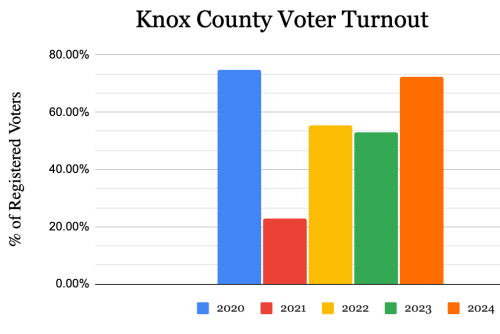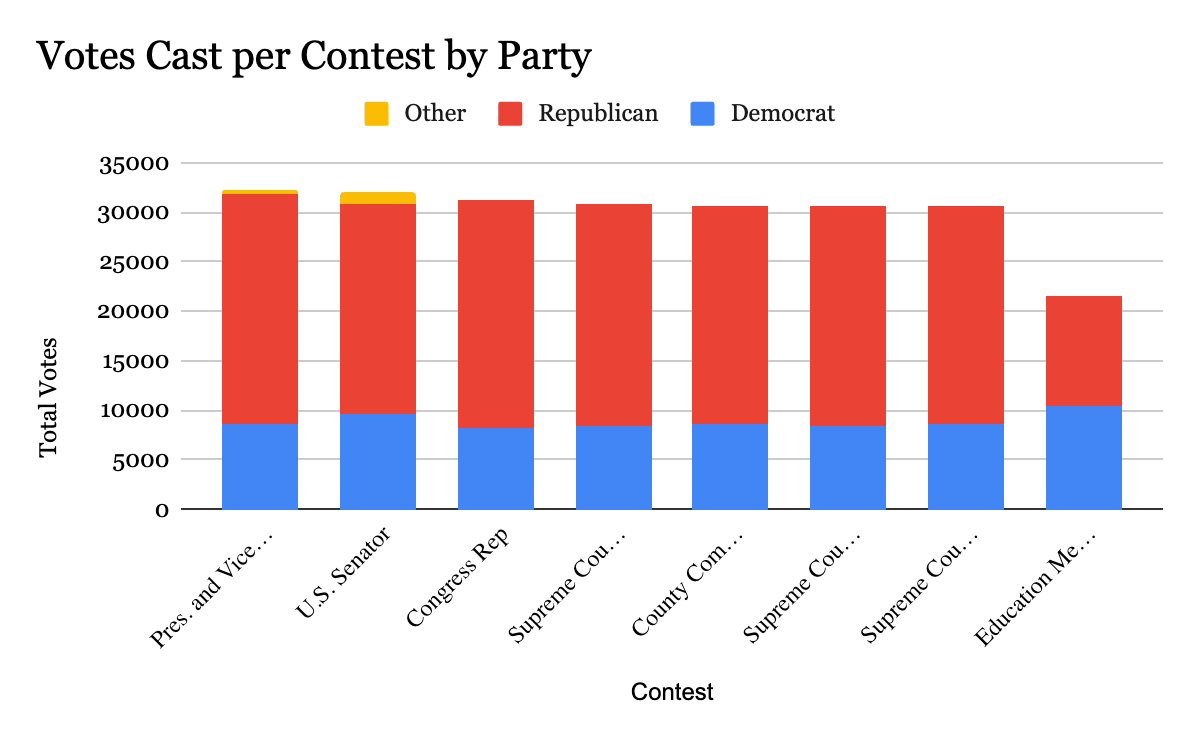On November 5, 2024, there were 43,806 registered voters in Knox County. 32,493 of those voters, or 74.17%, cast a ballot. This was Knox County’s highest voter turnout since the presidential election in 2020, though this was expected. Overall voter turnout is consistently higher in even-numbered years, where voters vote in presidential and midterm elections, than in odd-numbered years, where the races are typically for lower-level offices.
Figure 1:

As Figure 1 shows, voter turnout was higher in each of the three even-numbered years than in the odd-numbered years. In 2023, voter turnout was higher than expected for an odd-numbered year, perhaps driven by state ballot issues on marijuana and abortion.
While the attention is often centered on the major races, voters have the opportunity to weigh in on many matters at a more local level. One might presume that, because 32,493 voters cast a ballot, each county wide race would receive the same number of votes. Although there was a high overall voter turnout, it is quite common for voters to cast their ballots on the major races, and to leave blank ballots on races further down the ballot. This phenomenon is known as voter drop-off.
Figure 2:

32,277 voters cast a ballot for the president in the November election, slightly fewer than the total ballots cast of 32,493. Despite this, the presidential race received the highest number of votes cast among all races. In the U.S. Senate race, 31,974 voters cast a ballot, 303 votes fewer than the presidential race. Although the differences look slight, this trend continues. With each move down the ballot, voting drops off. 30,704 voters cast a ballot for the county commissioner, a 1,573 vote decrease from the presidential race, and only 30,560 voters cast a ballot for the justice of the Supreme Court (FTC 1-2-2025), 1,717 votes fewer than the presidential race.
By now, you may have noticed a glaring outlier in the data. The consistent and relatively shallow linear trend suddenly plummeted in the final race on the ballot for member of the state school board. Why, when the voter drop off was decreasing incrementally, was there suddenly an extreme drop-off?
To answer this question, we must examine the reasons behind voter drop-off. Voter drop-off probably occurs because major races receive significantly more attention, coverage, and campaign outreach than smaller races. Because smaller races lack the visibility of major races, it can be difficult for candidates to effectively convey to voters what they represent, or for voters to inform themselves on the race. As a result, as they go down the ballot, they may vote randomly or abstain from voting entirely.
The race for member of the state board of education was between Jessica Goeller and Rhonda Johnson. Voters had extremely limited information on the candidates. As we researched our voting guide for the 2024 election, CSAD reached out to Goeller for information on her campaign but received no response; at the time of our research a few weeks before Election Day, we found no endorsements from either party.
Voter drop-off affects not only the total votes cast for a race, but also who wins. The United States is currently polarized along party lines. In a polarized environment, we expect the margins of races to align with the proportion of registered Republicans and Democrats in the county. In Knox County, there is typically a 70-30 ratio of Republicans to Democrats.
Figure 3 is the same graph as Figure 2, now showing votes cast for the candidate from each party.
Figure 3:

The first seven races hovered around the 70-30 Republican to Democrat ratio, reflecting the partisan split in Knox County; the last race on the ballot was much closer. Goeller won with 51.3%, to Johnson’s 48.7%. Why did the smaller number of voters in the last race not break down along the normal party divide in the county?
This is the only race on the ballot where the candidates were not identified by party affiliation (even though, by election day, each candidate had been endorsed by one of the parties). In a race that gets very little attention in the news media, where the ballot offered no clues to the candidates’ views, and in which one party’s endorsement was difficult to find for most of the campaign season, many voters simply abstained from voting — 10,000 more ballots were cast for the presidential race than this race. Voters who did vote likely voted randomly, unclear of which candidate properly expressed their interests, which is shown in the almost 50-50 divide between the two candidates.
The large decrease in votes and strikingly close race may indicate that this race was especially impacted by the same factors that cause voter drop-off: limited information leads to uninformed voters, uninformed voters leads to voter drop-off.
Kiran Mediratta ‘27 is a CSAD student associate studying German.